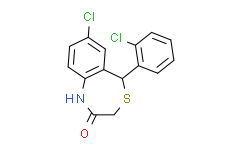| Cas No.: | 75450-34-9 |
| Chemical Name: | 7-CHLORO-5-(2-CHLOROPHENYL)-1,5-DIHYDRO-4,1-BENZOTHIAZEPIN-2(3H)-ONE |
| Synonyms: | 7-CHLORO-5-(2-CHLOROPHENYL)-1,5-DIHYDRO-4,1-BENZOTHIAZEPIN-2(3H)-ONE;7-chloro-5-(2-chlorophenyl)-1,5-dihydro-4,1-benzothiazepin-2-one;CGP 37157;CGP37157 (CGP-37157 );PF9 tetrasodium salt |
| SMILES: | ClC1=CC2C(C3C=CC=CC=3Cl)SCC(=O)NC=2C=C1 |
| Formula: | C15H11Cl2NOs |
| M.Wt: | 324.224940538406 |
| Purity: | >98% |
| Sotrage: | 2 years -20°C Powder, 2 weeks 4°C in DMSO, 6 months -80°C in DMSO |
| Description: | CGP37157 is a potent, selective inhibitor of Na+/Ca2+ exchanger, inhibiting the Na+-induced Ca2+-release from guinea-pig heart mitochondria, with an IC50 of 0.8 μM. |
| Target: | IC50: 0.8 μM (Na+/Ca2+ exchanger)[1] |
| In Vitro: | CGP37157 (Compound XVI) is a potent, selective inhibitor of Na+/Ca2+ exchanger, inhibiting the Na+-induced Ca2+-release from guinea-pig heart mitochondria, with an IC50 of 0.8 μM[1]. CGP37157 (10 μM) shows inhibitory effect on mitochondrial Na+/Ca2+ exchanger in cortical neurons, modulates intracellular Ca2+ levels via suppresssing voltage-gated calcium channels, and reduces NMDA-induced cytosolic and mitochondrial Ca2+ overloads. CGP37157 (10 μM) also reduces NMDA-induced excitotoxicity, and such an effect is via attenuating mitochondrial damage and calpain activity in neurons[2]. CGP37157 (10 μM) in combination with salinomycin significantly attenuates cell viability and increases apoptosis of FaDu and HLaC79 cells. Moreover, CGP37157 has no inhibitory effect on salinomycin tumor toxicity[3]. |
| Cell Assay: | Cell toxicity assays are performed. Neurons are exposed to NMDA in HBSS (free of Ca2+ and Mg2+) containing 2.6 mM CaCl2, 10 mM glucose and 10 μM glycine for 10 or 30 min at 37°C, depending on the experiment. CGP37157 is present before and during the excitotoxic insult and cell viability is assessed 24 h later using Citotox 96 colorimetric assay. All experiments are performed in quadruplicate and the values provided are the normalized mean ± S.E.M. of at least three independent experiments[1]. |
| References: | [1]. Chiesi M, et al. Structural dependency of the inhibitory action of benzodiazepines and related compounds on the mitochondrial Na+-Ca2+ exchanger. Biochem Pharmacol. 1988 Nov 15;37(22):4399-403. [2]. Ruiz A, et al. CGP37157, an inhibitor of the mitochondrial Na+/Ca2+ exchanger, protects neurons from excitotoxicity by blocking voltage-gated Ca2+ channels. Cell Death Dis. 2014 Apr 10;5:e1156. [3]. Scherzed A, et al. Effects of salinomycin and CGP37157 on head and neck squamous cell carcinoma cell lines in vitro. Mol Med Rep. 2015 Sep;12(3):4455-61. |

 To enhance service speed and avoid tariff delays, we've opened a US warehouse. All US orders ship directly from our US facility.
To enhance service speed and avoid tariff delays, we've opened a US warehouse. All US orders ship directly from our US facility.




















